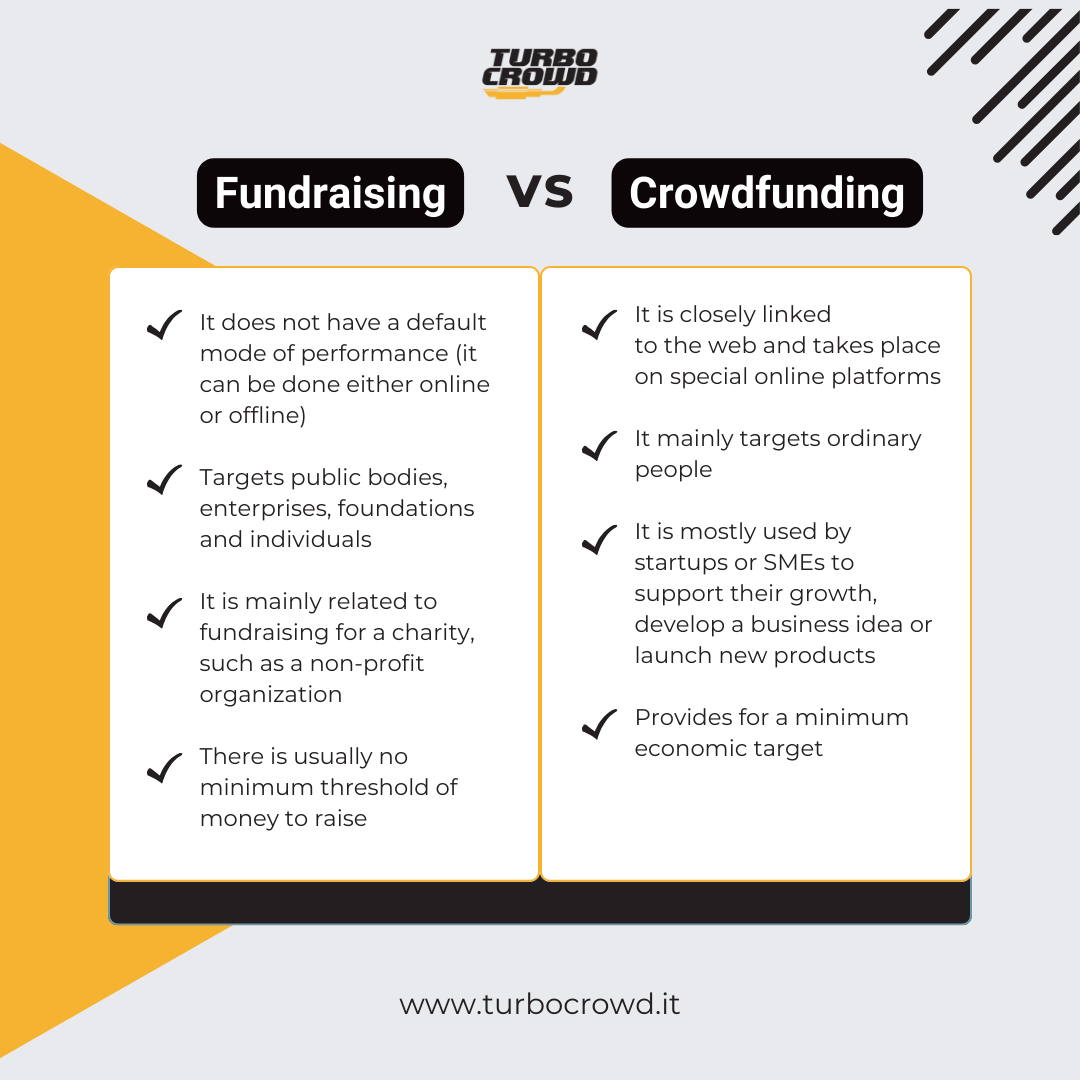- Relationship between fundraising and crowdfunding
- What are fundraising and crowdfunding for
- Regulatory and operational differences between fundraising and crowdfunding
- Want to learn more directly with our crowdfunding experts about the topic you are reading about?
- Do you need support in preparing a successful crowdfunding campaign and seeking potential investors for your project?
Fundraising and crowdfunding are two terms often used synonymously, but this usage can be confusing because there is actually a subtle difference between their meanings.
The first clue to distinguish the two concepts comes from the mere literal translation from English to Italian:
- fundraising simply means to raise funds;
- Instead, crowdfunding means "collective funding".
"Crowdfunding" is also often translated simply as "fundraising" in common usage. Sticking to its original meaning, however, helps to better understand its nature and difference from fundraising.
Relationship between fundraising and crowdfunding
It is clear how fundraising is a more generic term than crowdfunding. The former indicates a search for funding carried out by any means from any source, while the latter indicates fundraising carried out mostly online from a "crowd," a collectivity of non-institutional parties.
That is, crowdfunding differs from fundraising primarily because it is a specific subset of it. The concept of fundraising, in fact, encompasses all possible activities aimed at raising economic resources both online and offline from individuals, public and private entities, banks, calls for subsidized finance, any entity that might be interested in providing them. Crowdfunding, on the other hand, originated as the collection of funding "from below", that is, from ordinary people, carried out on the web. It is no coincidence that the first crowdfunding portal founded in Italy is called Produzioni dal Basso.
Today, crowdfunding is further divided into various types, which also involve the contribution of institutional entities, and it is possible, even desirable, to carry out offline activities to find financiers. However, the core of the phenomenon remains an online fundraising approach that offers an alternative to traditional sources of credit, thanks to the contribution of many individuals.
Fundraising, therefore, can make use of crowdfunding to raise funds for its goals, while the opposite cannot be said.
Want to learn more directly with our crowdfunding experts about the topic you are reading about?
Turbo Crowd can reveal to you all the tricks of the crowdfunding trade, explain the capital-raising opportunities available to you, and provide you with practical support to carry out a successful crowdfunding campaign.
What are fundraising and crowdfunding for
The meaning of words can change and define themselves over time in relation to their use and the evolution of the phenomenon they describe in reality. That is why as fundraising through a wide variety of alternative channels has become increasingly popular in Italy, the differences between crowdfunding and fundraising have become sharper.
Reading the definitions of the two headwords provided by Treccani, one can easily understand the distinction that has occurred through usage and is now fully established, to the point that it is considered a real mistake to use these two words as synonyms, whereas in the past it might have been accepted.
Crowdfunding is a "collective and collaborative fundraising, carried out through the web, open to anyone who decides to finance innovative projects and newly established businesses."
Fundraising, on the other hand, is an "activity of seeking funds necessary for the operation of nonprofit entities, carried out either directly by them or by specialized companies. The funds come from public agencies, businesses, foundations and individuals."
Three major points of divergence are immediately striking. Two we have already discussed in the previous section: crowdfunding is strictly web-based and carried out on specialized and regulated online platforms; fundraising, on the other hand, has no predefined way of carrying out its activities, it can be done through conferences, parties, exhibitions, dinners, door-to-door and even online; crowdfunding has an audience mainly of ordinary people ("everyone"), fundraising also targets various kinds of entities and lending institutions, although it does not exclude individuals.
The third point is the one that most demarcates the distinction and concerns the goal of the collection.
Over time, the concept of fundraising has become increasingly linked to charitable fundraising, while crowdfunding has moved away from it.
As is evident from the definition provided by Treccani, but also from any specialized resource, fundraising is primarily fundraising for the benefit of a charity, e.g., a non-profit organization, or a specific charitable or otherwise ethical-social project. For this reason, the search for fundraisers relies mainly on emotional involvement, identification in the ideals behind the project, and shared goals. Why not, also on the image advantage that can result, for example for a company or a bank, from supporting certain charitable operations.
Moreover, this involvement tends to be long-term: it goes beyond the moment of donation to create a community of people united by the same moral principles and interest in the same cause. People who perhaps become consistent supporters, with periodic donations or concrete actions in support of the cause.
Crowdfunding, on the other hand, is primarily an opportunity leveraged by innovative startups or SMEs to support their growth, develop a business idea, or launch new products. The goal, then, is generally profit, both for the companies launching crowdfunding campaigns and for the people who participate with their own money. This is why we talk about "crowdinvesting": those who fund a project through crowdfunding are making an investment, from which they expect to make a financial return following the success of the project. The financial return may come in different ways depending on the type of crowdfunding. In the case of reward crowdfunding, there is no financial return but there is still a reward, which is usually the new product made from the money raised by the campaign: it is never a free contribution.
From this point of view as well, there are overlaps between fundraising and crowdfunding. It is not necessarily the case, for example, that crowdfunding seeks or automatically generates limited involvement over time and in ways of interaction. Especially for equity-based crowdfunding campaigns, which transform investors into full-fledged shareholders of the company raising resources, the engagement is very high and long-lasting. In fact, the participants' interests are tied to the long-term success of the company, as it directly impacts everyone's gains. On the other hand, it is in the interest of any company conducting any type of crowdfunding campaign to maintain a strong connection with its supporters. This approach helps increase visibility, expand the customer base, and provides a base for future crowdfunding campaigns. Thus, fundraising and crowdfunding can share the common aspect of building strong supporter loyalty.
There is also a particular type of crowdfunding that also shares a social-ethical goal with fundraising: donation crowdfunding, which involves making a contribution to a project for a charitable cause of various kinds, without any reward, again through online platforms.

Regulatory and operational differences between fundraising and crowdfunding
We have seen that fundraising and crowdfunding differ in many conceptual aspects and their intended purposes, but they also have many commonalities.
From the point of view of implementing fundraising, in both cases the collection must take place in a manner prescribed by law. Crowdfunding, however, is subject to stricter regulations that are directly dealt with by Consob and the Bank of Italy, while fundraising is an operation with more flexible margins of action and subject to the tax regulations of nonprofit organizations (Art. 143 TUIR and Legislative Decree 460/1997).
For both those promoting fundraising operations and platforms and companies conducting crowdfunding campaigns, a key obligation is that of transparency, which requires disclosure to potential supporters of all information, both conceptual and economic, about the project to be supported and reports on the use of funds.
Another important difference in how these two categories work is that in fundraising there is usually no minimum threshold of money to be raised: the more you raise the better, the only limit set is time depending on the needs of the project, with a good deal of flexibility. Crowdfunding campaigns, on the other hand, mostly have a predefined time limit, a minimum financial goal. Below this threshold, the collection is often considered null. There is then a maximum goal reached at which the collection closes even if the time limit has not yet arrived.
If you want to find out more about the world of fundraising, sign up for the Turbo Crowd Facebook group, the first marketing consulting firm in crowdfunding: you will learn about realities that deal with all the growth opportunities available to businesses and personal projects and gain in-depth experience in the field.
Do you need support in preparing a successful crowdfunding campaign and seeking potential investors for your project?
Turbo Crowd can accompany you throughout the process, from organizing the precrowd to closing the collection, developing effective and innovative marketing strategies to best promote your campaign.











































